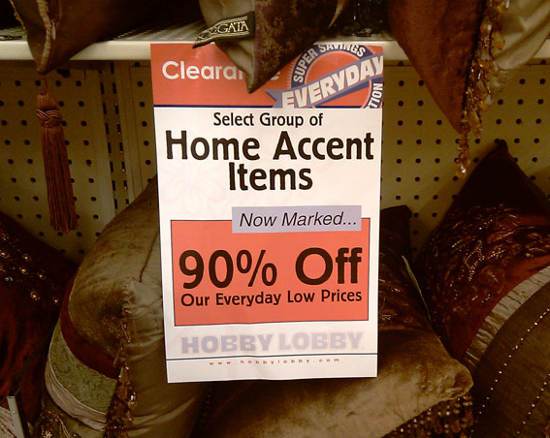90% Off An Imaginary Price Is Not A Sale
Paul Michael at Wise Bread thought that he had found a great deal on throw pillows at his local Hobby Lobby store. Signs advertised ninety percent off! Imagine that, a $50 fancy throw pillow for only five bucks! It was only when he looked closer that he noticed that the “original” prices were surprisingly high for mass-produced pillows: about $90 to $120. Research online showed similar pillows from the same company for sale for around half that. Just what was going on here?
I have to ask myself, were these pillows ever sold for the original price? Did they even get close to it? Or was this some ploy to bring people into the clearance aisle to grab pillows, only to give them sticker shock and have a good laugh. I would have asked a store clerk, but it was lunch time and the only two that were around were dealing with lines 6-people deep. No one had any pillows by the way.
I’m not saying $9-$12 is a lot to pay for a pillow. Not at all — it’s decent. That’s not the point. It’s the whole “90% OFF” thing that bothers me. Look again, and you’ll notice the full sign reads “90% Off Our Everyday Low Prices.” Really? $120 for a throw pillow is an everyday low price? Maybe for the Sultan of Brunei, but for an average family on an average income, it’s not even in the same ballpark.
If indeed the pillows were never for sale at those original prices, the Federal Trade Commission has some interesting things to say about this. They are, as you might guess, against it, explaining in one of their guides for consumers:
One of the most commonly used forms of bargain advertising is to offer a reduction from the advertiser’s own former price for an article. If the former price is the actual, bona fide price at which the article was offered to the public on a regular basis for a reasonably substantial period of time, it provides a legitimate basis for the advertising of a price comparison. Where the former price is genuine, the bargain being advertised is a true one. If, on the other hand, the former price being advertised is not bona fide but fictitious — for example, where an artificial, inflated price was established for the purpose of enabling the subsequent offer of a large reduction — the “bargain” being advertised is a false one; the purchaser is not receiving the unusual value he expects. In such a case, the “reduced” price is, in reality, probably just the seller’s regular price.
If you suspect a retailer of price trickery, we’d suggest contacting your state attorney general’s office. You can find their phone numbers here, and Paul can find his AG’s consumer protection office right online.
Hobby Lobby, Who Exactly Are You Trying To Fool? [Wise Bread]
FTC GUIDES AGAINST DECEPTIVE PRICING [FTC]
Want more consumer news? Visit our parent organization, Consumer Reports, for the latest on scams, recalls, and other consumer issues.


